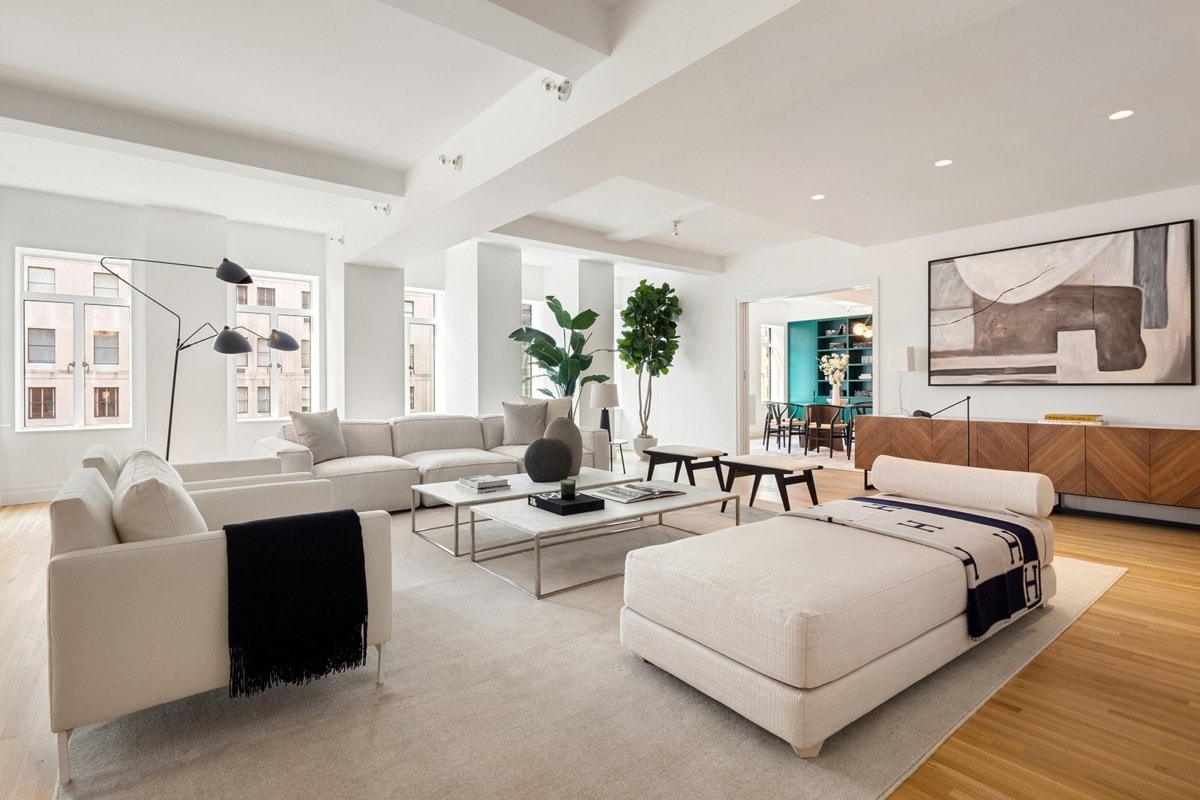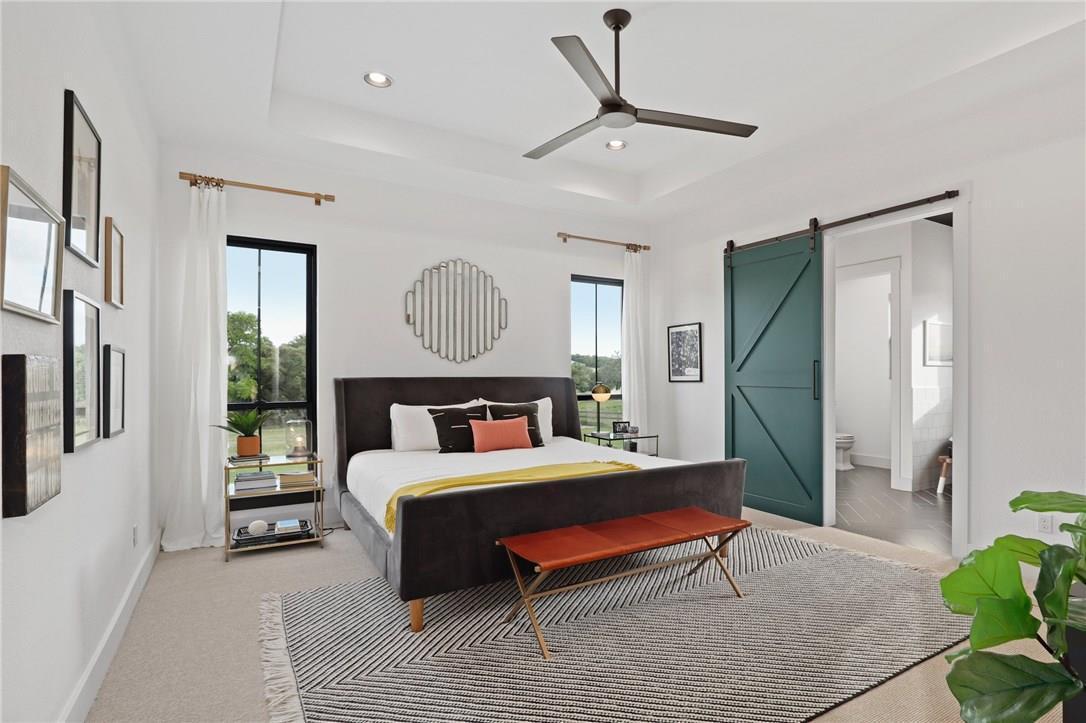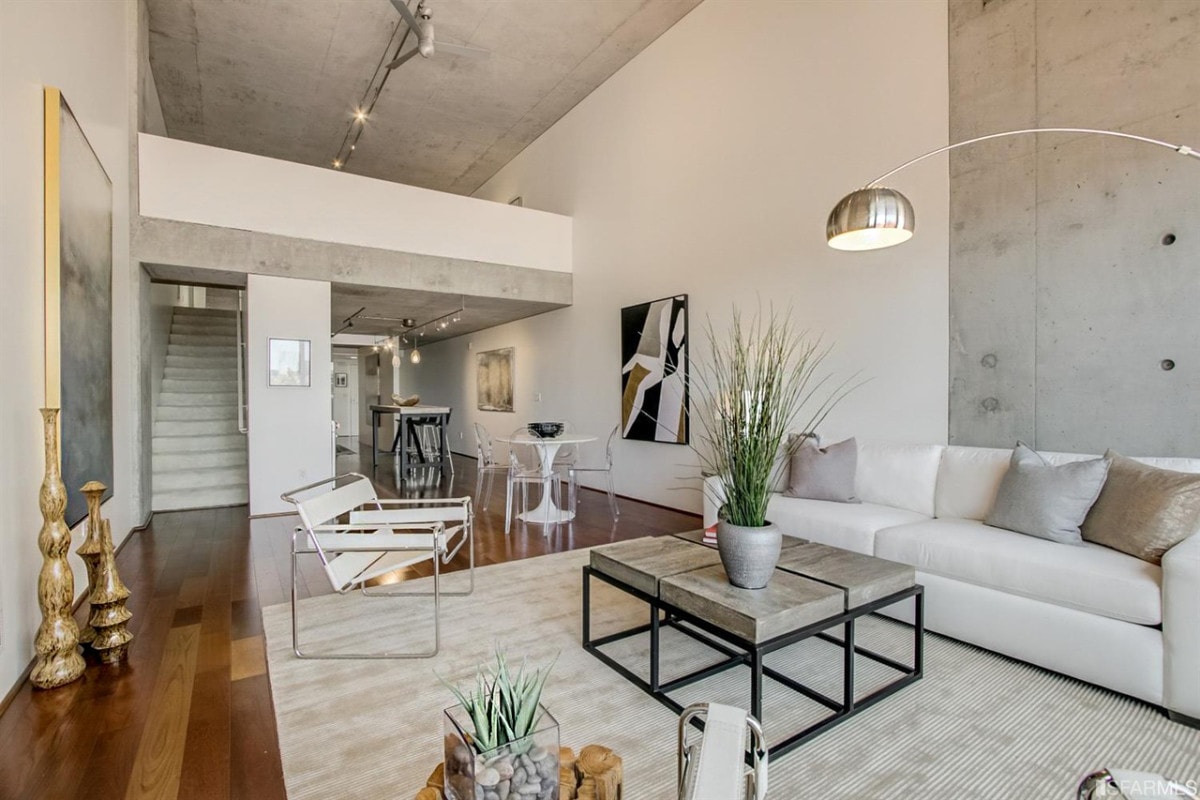We are two months into 2025, and like many of us, you may have forgotten about your New Year’s resolution to create a minimalist home and keep it organized. But fear not: This Redfin article is here to help you, whether you’re in an apartment in Dallas, a new home in Fort Utah, or a rental home in Ann Arbor, you can make your home stylish yet subtle by creating a minimalist home interior. These 10 tips will help you begin designing a more minimalist home, helping you learn how to live better with less.
Before we begin, Patrick from Maximize Minimalism shares key points to consider when choosing a minimalist home and lifestyle. Patrick says, “We personally feel that creating an inviting, minimalist space at home starts in the mind, rather than in a design. Once the mind is oriented around certain principles, creating the space falls into place.
The first principle that comes to mind is to recognize that less is more. We feel that the mind tends to think in terms of adding by default, rather than subtracting. I encourage anyone interested to look around their home or office and think about what can be taken away (or at least put away). How can the space be made simpler? You may be surprised to find just how many things come to mind! When we do buy furniture or decor, it’s preferable to buy a handful of high-quality items rather than many more inexpensive ones. Rearranging is our friend, too.
Another is to follow one’s intuition and let the energy you feel guide you. What feels cluttered, disorganized, or stressful? Which portions feel closed off or cramped? These are easy places to start as far as subtracting from, or at least optimizing our space is concerned. It’s our belief that many parts of our personal space can subconsciously affect how we feel when we spend time there – especially over days, weeks, and months.”
Got it? Great: Now let’s dive into the top tips to clean up your space and transform your space into the best minimalist home for you.

1) Keep clutter to a minimum
One of the main reasons you might be looking for minimalist home décor is due to the clutter your home has accumulated over the years. If you’re looking for a way to begin – start small.
That may be spending five minutes a day decluttering your space, organizing room-by-room, or simply clearing off any surface clutter. Katie Zurawski, The Decluttering Queen, shares advice on how she keeps the kitchen and bathroom clutter-free.
She says, “One of my best tips for creating a more minimal, peaceful living space is to reduce the amount of visual clutter in high-traffic rooms like the kitchen or bathroom. People tend to line the entire kitchen counter with small appliances, utensils, and more. To create a simpler space, start by organizing items into categories, such as cooking tools, cleaning supplies, or toiletries, and limit each grouping to only the essentials. In the kitchen, keep only the most used utensils and appliances on the counters, storing away extras. For the bathroom, group similar products together, like skincare or hair care, and discard duplicates. You also want to give the eye a place to rest (it seems silly, but it works). Don’t have every inch of your countertop filled. Instead, cluster items together in little groupings, creating space around them that’s empty.”
Elita Torres of Lead Grow Develop adds, “If you want to declutter and create a minimalist space, there are simple ways to accomplish this without removing all the personality in your room. It starts with investing in timeless pieces that are intentional and add purpose to your room of choice. Layered lighting can create depth and functionality while maintaining the look. Using your vertical space, such as adding floating shelves or wall hooks, will keep your floor uncluttered. Adding a personal touch that represents you, such as your favorite books or a prized collection, will add to your room’s theme. Once your room is complete, don’t forget to declutter once in a while, as it can get easy to lose your room’s original vision.”
Patrick, founder of Squeaky’s Cleaning Services, shares additional advice on decluttering your space: “Start with what I call the “Clean Canvas Method” – rather than just decluttering, completely empty one room at a time and deep clean every surface, corner, and crevice. This process helps you mentally reset and carefully consider each item’s return to the space. Think of your rooms like a breath – they need both inhale (functional items) and exhale (empty space) to feel balanced and alive.
Also, consider implementing the ‘Three Surface Rule.’ Only allow three horizontal surfaces in any room to display items (excluding furniture), and ensure these surfaces are thoroughly cleaned daily. This naturally limits accumulation while maintaining a pristine, intentional appearance.”
Renovating your home?
Find out what your home's worth, edit facts, and see the impact of home projects.
2) Make sure you have enough storage
Renovating your home?
Find out what your home's worth, edit facts, and see the impact of home projects.
An easy way to keep the clutter at bay is to have enough storage to stow away your things properly. Lack of storage space can prevent you from achieving your goal of a minimalist home and lifestyle. However, that doesn’t mean you should start buying more things than you need.
Having optimal storage will allow you to store what you need in its proper place without clutter overflowing into your living spaces. Angele from M· Style Alley notes, “A minimalist space isn’t just about decluttering — it’s about creating a home that feels intentional, functional, and inviting. Storage is key: Hidden compartments, wall-mounted shelves, and stylish baskets help maintain a clutter-free look while keeping essentials accessible.”
Emma Kenwrick-Meehan, professional organizer and home stylist for Home Nip and Tuck, agrees with choosing a functional design by stating, “Choose multi-functional furniture (such as storage ottomans or wall-mounted desks) to maximize space without adding visual clutter. Using hidden storage solutions such as built-in cabinets, or under-bed storage is key to keeping everyday essentials out of sight but easily accessible.”
Once storage space is provided, Jared from Juujbox, a moving box rental and storage service, shares how to keep your home minimal and tidy. Jared says, “One of the best ways to maintain a minimalist home without sacrificing warmth or functionality is to adopt a ‘store what you don’t use daily’ mindset. Keep only your most essential items within reach and utilize off-site storage for seasonal decor, rarely used appliances, or sentimental belongings that you don’t want to part with.”
3) Choose light colors to brighten up your space
The first step in creating a minimalist home is to choose light colors as your base. Think whites, beiges, light grays, or any neutral color variation that you like best. But don’t be afraid to add some splashes of black, too. Having these contrasting colors will help create dimension in your living area.
Veiko Kallas of JALG TV Stands speaks about the color choices optimal for minimalist living. Veiko says, “A minimalist space doesn’t mean stripping everything away — it’s about thoughtful choices that create balance, warmth, and functionality. Start with a neutral foundation of soft whites, warm beiges, or muted grays to establish a calming atmosphere.”

Bring the holidays home with Redfin Redesign
Claim your home to create your ideal holiday space with garlands, lights, and festive touches, or use Redesign on any Redfin listing!
4) Use pops of color as accents
Just because a minimalist home interior highlights a neutral color palette doesn’t mean you have to turn away from color. Choosing the right pops of color in your home can bring personality and add brightness to your space. Consider warm colors like mustard yellow or rust orange pillows on a crisp white chair or the right piece of artwork against light-colored walls, like a sunset painting or abstract drawing. Home trends may come and go, but incorporating the right touches of color into a minimalist home design can create a timeless space.
5) Streamlined, functional furniture for a minimalist home
Whether you have a popular home style or something more unique, designing a minimalist home interior takes time and thought. As Annie Linder, owner and publisher of Enchanting Nest suggests, “I’ve found that creating a minimalist space begins with thoughtfulness as a guiding principle – each item should serve a purpose, bring joy, or both.
Investing in well-crafted furniture pieces with clean lines and multiple functions, like storage ottomans or expandable dining tables, maintains functionality while achieving a clean look. One of my favorite aspects of the minimalist aesthetic is how it encourages intentional choices, with each item earning its place through purpose or meaning to create a space that feels both peaceful and personal.”
6) Creating dimension with texture and space
To create contrast and interest in your space, it’s important to use a variety of textures. Try mixing materials like a chunky wool blanket on a brushed velvet couch with linen curtains to frame your windows. This way, you can stick to a sleek color palette without making your home appear one-note.
Hayley, a decluttering coach of Simple Joy, notes, “Introduce texture through natural materials like linen, wool, or wood to add depth and coziness. Instead of filling shelves with random decor, display a few meaningful pieces — perhaps a vase or a framed print with sentimental value. Also, be sure to embrace negative space; not every wall or surface needs to be occupied. Let your home breathe!”
Annemarie Schumacher, founder of Make Every Day an Event, shares advice and an example of creating a warm minimal space using texture.
Annemarie writes, “To create a cozy factor while maintaining a minimalist aesthetic, it is essential to incorporate both texture and natural wood into the design to add interest and warmth. In these situations, I recommend starting with a neutral base and build from there. For a living room, begin with a monochromatic foundation, such as an ivory sectional, cream-colored area rug, and neutral wall colors. From there, curate your accessories wisely, considering both form and function. You don’t want anything busy with a lot of patterns. You also want to limit yourself to only a pop of one or two colors at most. Great choices are a higher pile area rug, velvet or suede toss pillows, and wooden accents to create a cozy feel. Chunky throws are also great pieces to incorporate. Not only are they functional, they are also immensely practical, especially on chilly nights.”

7) Decorate your space with purpose
One of the reasons you may be looking to design a minimalist home is because of all the knick-knacks cluttering up your space. When decorating your space, it’s important to choose pieces with intention – ones that mean something to you. For example, Shannon from Arner Adventures a blog focused on living minimally, shares her advice on choosing pieces. Shannon says, “Curate, don’t collect – Instead of filling shelves with tchotchkes, choose meaningful pieces that tell a story. If you traveled to Venice and fell in love with a Murano glass lamp, bring that back to your space. Surrounding yourself with intentional, functional items adds personality without unnecessary clutter.”
Julie of Becoming You With Julie adds an important question to consider when decorating a space, she says “I like to begin with the end in mind: What is the purpose of the room? Is it a space for focus, relaxation, or connection?
Once you define your intention, anchor the design around an essential piece — a well-crafted armchair, a textured rug, or a solid wood table that provides function and sets the tone. Each piece should be thoughtfully chosen — multifunctional furniture and natural textures bring cohesion and warmth. Eclectic pieces add character, as long as they support flow and harmony, not clutter.”
Heather Spiva of Simply Minimally reinforces the idea of making your home uniquely yours. She writes, “A home is a home because you love what’s in it. And your home becomes your sanctuary when you’re surrounded by the things you care about, want to look at, and enjoy.
If you’re looking to live a minimal lifestyle with a home that is maximally satisfying to you, get rid of anything that’s excessive. We’re talking trinkets, extra books, nick-nacks, and decor that doesn’t have a place and only collects dust. Keep only a few essential decorative pieces that you LOVE. Donate the rest.”
8) Add greenery with plants
While it may seem counterintuitive to have bright greenery in your home when sticking to a neutral color palette, incorporating plants into your home can help tie your space together. Houseplants add an element of natural beauty and can breathe new life into your home while staying also minimal.
Rosalin Ortega, CEO and founder of All About Planties, shares the following tips for incorporating plants into your home:
- Maximize vertical space with indoor plants: When floor space is limited, vertical storage and decor solutions are key. Floating shelves, tall bookcases, and hanging plants like pothos or string of pearls draw the eye upward, making the space feel less cramped while adding a natural touch.
- Divide with purpose using greenery: To create privacy in the linear layout, use multi-functional furniture like folding screens or tall houseplants. Plants such as monstera, fiddle leaf fig, or snake plants serve as natural dividers while improving air quality and adding vibrancy.
- Optimize natural light for a healthier indoor environment: These apartments often have windows concentrated at the ends. To enhance livability, position light-loving houseplants like peace lily or bird of paradise near windows and use mirrors to reflect natural light throughout the space.
- Keep the flow clear with thoughtful plant placement: With the narrow, long design, it’s important to maintain an uncluttered walkway. Use minimalist furniture arrangements and place compact, low-maintenance plants like ZZ plants or peperomia on shelves or in corners to keep pathways open and functional.
9) Designing a minimal office
Keeping a clean minimalist office is key for productivity and relaxation. As Jim of Office Finder states, “The rise of home offices has prompted many to seek the perfect workspace setup. Balancing professionalism and comfort is key, aiming for a productive yet relaxed environment. A minimalist desk design will change the way you work. Minimalist desk designs can be a great solution, fostering productivity by creating an open and comfortable space. Plus, it’ll look just plain beautiful.”
Pete, chief blogger of Living the Tech adds, “In the modern minimalist home office, less is definitely more. Choosing a de-cluttered and streamlined look allows you to create a space that helps you focus, be productive, and feel calmer.
De-cluttering your home office can change how you work, think, and feel. Begin by looking at your space and finding items you don’t need anymore. Sort your stuff into three piles: keep, donate, and throw away. This not only gets rid of clutter but also makes your space look better, more organized and forces you to think about what you value.
Implement a “one-in, one-out” policy: Before adding a new item, think about removing something else to keep your space balanced and clutter-free. Also, establish a clear filing system. Keep important documents digital and have a simple filing system on your desk to avoid paper clutter.”
Daphne Gray-Grant, The Publication Coach, adds a way to keep your space minimal and provide health benefits without sacrificing space. She says, “My best advice for a minimalist home office is to get yourself a treadmill desk. I’ve used one for the last seven years and not only does it look great, but it also keeps me in shape. I get 20,000 + steps most working days. My desk can be raised or lowered with the press of a button and the treadmill component slides right underneath it. There are no arms to the treadmill, and I operate it with a remote control. Yes, it is possible to walk and type at the same time! I rest the palms of my hands on the edge of my desk while typing, which keeps me nice and stable.”
Looking to save money on your mortgage?
Reduce your monthly payments by refinancing now.
10) Use natural light to warm up your home
When you’re looking for the right place in your home for your new houseplants, make sure to lift your window shades to give them (and you) some much-needed light. Sunlight can add warmth to your neutral furnishings and can go a long way to make your house feel like a home. On cold days, it’s important to embrace what natural light your windows let in to keep your space feeling airy and bright. Even if you live in a city where there isn’t much sunlight, like Portland, OR, use breezy, sheer curtains to highlight your windows or place a mirror to help spread natural light around your space.
.png)
 German (DE)
German (DE)  English (US)
English (US)  Spanish (ES)
Spanish (ES)  French (FR)
French (FR)  Hindi (IN)
Hindi (IN)  Italian (IT)
Italian (IT)  Russian (RU)
Russian (RU)  5 days ago
5
5 days ago
5









Comments